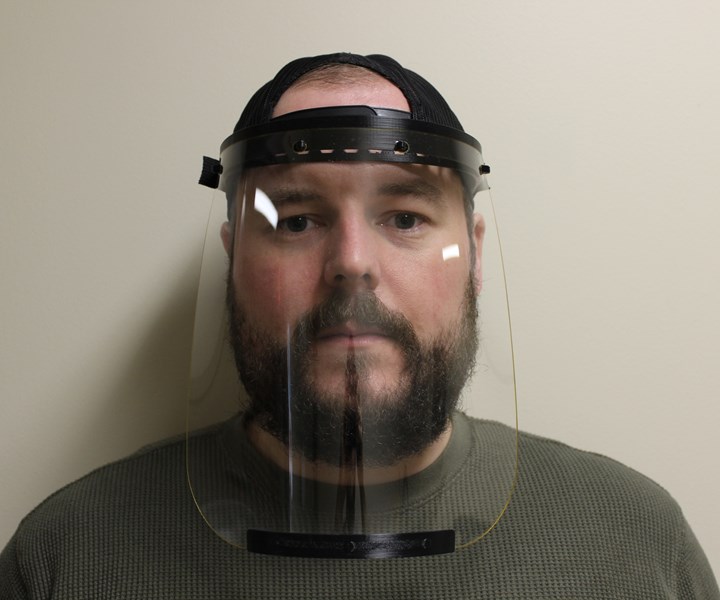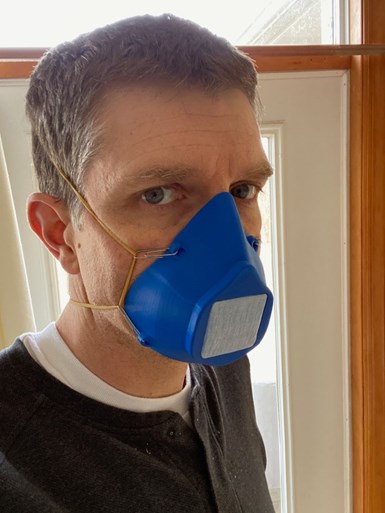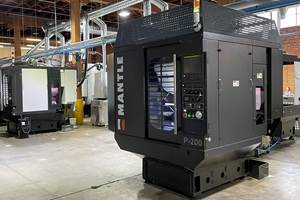Additive Manufacturing in the Age of COVID-19
Reporting from the front lines of the fight against Coronavirus — how my journey began.
Share





Like many around the world, my life, work and travel plans were upended as the coronavirus made its way to the United States. By the time we returned home, all of Penn State’s classes were told to move online, and I had a weekend to figure out how I was going to teach the undergraduates in my additive manufacturing (AM) and reverse engineering course how to operate 3D printers and gain hands-on experience with 3D scanning. As you might guess, it is quite hard to run a hands-on AM lab course when students are prohibited from setting foot on campus and cannot enter the labs.

Figure 1: Zachery Smith in Penn State’s Applied Research Laboratory (ARL) wears a prototype of the Prusa 3D printed face shield (Image: Charlie Tricou, ARL)
Like many other faculty and teachers facing similar situations, I started searching online for new ideas and materials for my course. I was delighted to reconnect with friends, contacts and collaborators at 3D Systems, Autodesk, Xometry, nTopology, RePliForm, 3Degress Consulting, Link3D, The Barnes Group Advisors and many AM companies and service providers that were rapidly mobilizing to share content online, make software freely available to students, and do their best to remain open and offer their services as the United States started to close down. I am forever indebted to them for their assistance and suggestions, and I am delighted to hear what they and the countless others in the AM community have done, and are doing, to help fight COVID-19.
Thinking of Additive Manufacturing Solutions to COVID-19 Problems
As I was reconnecting with these folks on LinkedIn, I started seeing posts from my connections around the world who were already battling coronavirus. First on this list was probably the duo in Italy who saved lives by redesigning and 3D printing replacement parts for ventilators in their local hospital. Around the same time, Materialise started sharing their 3D printed hands-free door opener, which circulated quickly on Twitter and other social media. Their design soon found its way to HP’s newly launched 3D printing website to help with COVID-19 as the company was collecting cool ideas to help nurses, doctors and other healthcare workers on the front lines. Meanwhile, the team from Prusa in Prague released the 3D printed face shield design that they had quickly developed and prototyped.
By the time I stumbled on the 3D printed foot pedal door opener from Professor Olaf Diegel and his students at the University of Auckland, I knew it was time to redirect my class project and challenge the students in my AM class to design, develop and prototype their own ideas to help contain the spread of coronavirus. Having my students make and test a bunch of random 3D printed parts on some material extrusion systems in an AM lab to quantify variability just did not seem important anymore — plus they could no longer access the AM lab anyway. Luckily, a lot of engineering students have their own 3D printers on hand these days; so, my immediate project and lab challenges were solved, and I migrated my lectures online with little hassle.
Putting AM to Work
Meanwhile, as I read these articles and online posts for my class, I started sharing them with friends and colleagues in our 3D printing network across Penn State University, Penn State’s Applied Research Laboratory (ARL), and local companies and industry partners. At the same time, I also reconnected with colleagues at Penn State’ College of Medicine at the Hershey Medical Center, knowing that they were likely preparing for the onslaught that was coming. Within a day, hundreds of emails started flying around, numerous new connections were formed, and some semblance of priorities were established. Within two days, the team at the ARL had 3D printed, laser cut, and fabricated the Prusa face shield (see Figure 1). The team at Penn State’s Hershey Medical Center loved the effort and the result, and we quickly started identifying other areas where AM could help.

Figure 2: Matt Parkinson, a faculty member at Penn State, shows off the “Billings” filtration mask that he 3D printed for testing (Image: Matt Parkinson, Penn State).
Ventilators, filtration masks, and other Personal Protective Equipment (PPE) immediately joined the list. We then 3D printed and tested the filtration mask (see Figure 2) that was by the group in Billings, Montana.
The feedback from the doctors at Penn State’s Hershey Medical Center, which tested our 3D printed filtration masks, has since led to modifications to improve comfort and fit while reducing printing time. This rapid feedback was only made possible through AM, but we all quickly realized that the demand was going to outstrip the supply — and that was just for one hospital. After joking that we would need to fill Penn State’s Beaver stadium with 3D printers in order to meet the demand that was being projected, we pivoted and started redesigning the 3D printed face shields, filtration masks and other PPEs for fabrication with more traditional methods (for example, injection molding, vacuum forming). These methods could be performed within an ISO-certified, GMP-compliant facility to help meet FDA regulations, and the resulting PPE could be more easily sterilized.
AM is great, but you can imagine all of the nooks and crannies that a virus could hide in on a 3D printed object. Worse, many of the sterilization protocols that were being proposed for decontaminating PPE for reuse (such as heating to a high temperature in an oven) would melt and deform many of the polymers people were using on their 3D printers. So, like many, we are now building out a network of companies that can help us meet industry standards and comply with FDA regulations, which are changing daily as the number of infections skyrockets. The fight has only begun, and we hope we are not too late.
To learn more about Penn State’s Manufacturing And Sterilization for COVID-19 (MASC) initiative, visit this .
Related Content
In Moldmaking, Mantle Process Addresses Lead Time and Talent Pool
A new process delivered through what looks like a standard machining center promises to streamline machining of injection mold cores and cavities and even answer the declining availability of toolmakers.
Read MoreMachine Tool Drawbar Made With Additive Manufacturing Saves DMG MORI 90% Lead Time and 67% CO2 Emission
A new production process for the multimetal drawbar replaces an outsourced plating step with directed energy deposition, performing this DED along with roughing, finishing and grinding on a single machine.
Read More6 Trends in Additive Manufacturing Technology
IMTS 2024 features a larger Additive Manufacturing Pavilion than ever before, with veteran suppliers alongside startups and newcomers at the front of the West Building. As you browse these exhibitors, as well as booths found elsewhere at the show, keep an eye out for these trends in AM.
Read MoreOEMs Showcase Hybrid Manufacturing Applications
Mazak and Mastercam worked together to demonstrate the viability of hybrid additive/subtractive machining techniques at a recent event held in Florence, Kentucky.
Read MoreRead Next
The extensive design freedoms offered in additive manufacturing can be paralyzing. With AM consistently pushing the boundaries of manufacturing, how do we teach people to take risks and be creative with AM?
Machine Shop MBA
Making Chips and 91ÊÓƵÍøÕ¾ÎÛ are teaming up for a new podcast series called Machine Shop MBA—designed to help manufacturers measure their success against the industry’s best. Through the lens of the Top Shops benchmarking program, the series explores the KPIs that set high-performing shops apart, from machine utilization and first-pass yield to employee engagement and revenue per employee.
Read MoreAMRs Are Moving Into Manufacturing: 4 Considerations for Implementation
AMRs can provide a flexible, easy-to-use automation platform so long as manufacturers choose a suitable task and prepare their facilities.
Read More






















